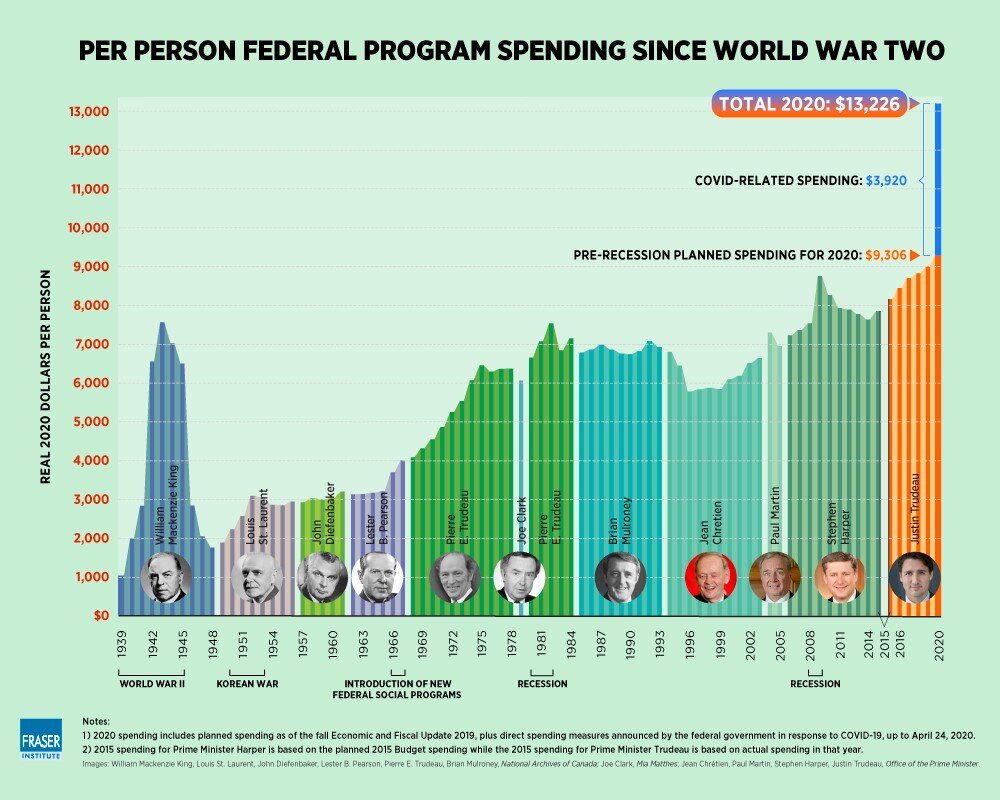We have grown concerned about the dramatic increase in government spending in Canada. Even prior to the pandemic the federal government and many provinces were running at record levels of spending and deficits, which was pushing total debt levels well over historic highs. The pandemic stimulus efforts have taken the deficit spending beyond levels imaginable. We have reviewed several articles and statistics that economists and the government use and have pulled together the most interesting facts to put the spending, deficit and debt levels into perspective.
Federal Spending per Person
The Fraser Institute is currently quite focused on our topic. They produced a full report on spending by prime minister in May 2020. The chart below provides a great review of spending per year, by prime minster. Unsurprisingly, the largest increases in spending (outside of World War II) have been while a Trudeau is Prime Minister. Since the report was published, the Federal Government released its fiscal update on July 8 and the projections from May were way off. Federal spending per person is now expected to reach $15,596 in 2020, approximately 18 per cent more than expected in May.
Photo from Fraser Institute
Federal Deficits – Actual Dollars
As you can see below, the current year’s (2020/2021) deficit is like nothing we have seen this century.
Source: Department of Finance, Canada
How did this happen? As presented in the timeline below, deficit spending was the plan all along. However, even prior to COVID, the federal deficit had jumped from $19.8 billion to $26.6 billion or 34 per cent. Once COVID hit, estimated spending ballooned to $343 billion and is now loosely estimated to exceed $400 billion.
As Chris George mentioned in his August 28 editorial - the current Liberal Government has outspent all past federal governments, including those governments that had to respond to world wars and global recessions. The most recent fiscal snapshot suggests the federal government was unlikely to balance the budget until at least 2040 (and this was assessed before COVID-19 measures).
Total Debt Increase in 2020
The COVID-19 pandemic is a global economic disaster. Almost every region of the world has been impacted. However, not all federal governments have responded by spending at the same level as Canada. The average increase in total debt per capita expected by G7 countries this year (excluding Canada) is approximately $2,500 per person. Canada’s increase in total debt per capita is planned to be $6,200 per person. The US has also increased its total debt per capital significantly this year – by almost $10,000 per person. The following chart shows the expected total debt increase per capita from 2019 to 2020 by each G7 country.
Sources:
Debt Info from Source: International Monetary Fund | April 2020;
Population info from The World Population Review - https://worldpopulationreview.com/
To give a different perspective of the above data, the following chart shows the 2020 total debt level for each of the G7 countries. The increase from 2019 is highlighted and the per cent change is noted at the top of each bar.
Sources:
Debt Info from Source: International Monetary Fund | April 2020;
GDP info from The World Bank - https://data.worldbank.org/indicator/NY.GDP.MKTP.CD;
Population info from The World Population Review - https://worldpopulationreview.com/
Why has Canada spent so heavily? Was Canada and the US disproportionately impacted by the pandemic? Are Trudeau and Trump spending fiends?
We believe both governments decided to use the debt spending as a tool to offset the economic crisis that resulted from the pandemic shutdowns. It was an “easy” tool to use and the downside was not likely to be catastrophic based on the experience of countries with very high debt loads, like Japan and Italy. However, one could ask how much of this “tool” should we use now? Its availability is a result of years of prudent financial management and an economy that has provided stable gross domestic product growth over generations. Do we want to become like other countries in the world that have used their ability to borrow already? The higher the debt, the higher the cost of the interest for future generations. Future Canadians will pay the price with reduced services. However, with interest rates expected to stay near 0 per cent for many years – the future cost of the increased debt is not currently of grave concern. The chart below shows Debt as a percentage of GDP for the G7 countries from 2015 to 2020. Relative to the other G7 countries, Canada’s total debt level is quite a bit lower – even after the spending binge of the last four months.
Based on the projections provided to date, the federal debt will exceed $1.2 trillion by the end of the current fiscal year. It is likely to be even higher once Trudeau’s upcoming spending plan and budget is released. Based on the relative data compared to other G7 countries – Canada can endure more deficit spending in the short term, but we need to ask ourselves are we getting value for the spending? What are we spending our “rainy day” fund on? Will it spur the economy in such a way that we grow our way out of the economic issues? Will our lives be better because of this spending? We suspect the government is going to pose that question to us in the coming months… How will we respond?










